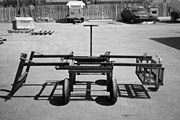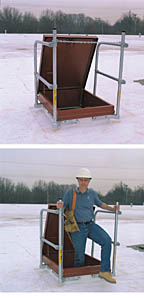Fall Protection on the Move: Literally and Figuratively!

The argument over how much is enough in terms of fall protection for roofing workers continues several decades after it began in earnest. No roofing contractor has ever doubted the fact that falls are a not good thing. Even though some jobs and some situations are still subject to question and controversy, we now assume fall protection is a routine and necessary part of our lives in the roofing industry.
We will discuss two new schemes, both developed by former contractors, that answer a couple of basic questions. The first is one that the industry has struggled with for many decades: “OK, I will tie off when near the roof edge on this low-slope roof. Now would you tell me where to do that? And will it provide a proper and sufficient anchor?” The next question involves an emerging trend, long ago recognized by OSHA, and that is: “OK, Mr. Building Owner. The contractors are gone, but your maintenance people are still on the roof hanging around the edges, climbing up through hatches, and milling around skylight and other roof openings. How are you protecting them from falls?”
Tie Off To WHAT?!
Most roofing contractors routinely employ one of several systems for fall protection on low-slope commercial roofing jobs where there are open sides (no parapet wall high enough to comply as adequate fall protection) and/or openings for skylights, hatches or other openings. They utilize warning line systems, safety monitors or guardrail systems. Some use scaffolding and nets or other apparatus that function on the side of the roof, or in conjunction with other trades working the upper portions of the building’s exterior or on the roof itself. In the case of almost all of these solutions, there is a point in which they fall short of complete protection, and the workers must utilize personal fall protection systems (PFAS) equipment.Despite their effectiveness, PFAS have a number of limitations. They are not particularly comfortable to wear. They are expensive to own and must be maintained to a considerably higher degree than that of other construction tools. Being active restraints, proper operation of these schemes requires a lot more operator training than passive restraints such as guardrails. The attendant ropes and lanyards are constantly in the way, and provide a distraction from the work at hand. And mechanics generally despise using them.
Just the same, there are places where passive restraints are impractical, expensive, or simply impossible to employ. PFAS are a sound, proven and reliable alternative providing that they are properly installed and used. In many situations, they are the only option.
So you are on this low-slope roofing job and you have chosen a warning-line system. It is abundantly clear that you must employ PFAS for workers who are going to complete the work at the roof’s edge. Nothing else will do. You have read all of Chip Macdonald’s articles about PFAS (especially Roofing Contractor April 2001, p 42). Now where do you attach the PFAS to the structure? And how do you know it will meet the requirements per OSHA standards, as well as those recommended by the manufacturer of the PFAS equipment?
Until now, there has been no “stock” answer. Now there is an anchorage device that is both portable and reusable on many low-slope roofing jobs. This fall protection solution is on the move – literally.
Former roofing contractor Ted Palmer of Protective Roofing Products Ltd., Stoney Creek, Ontario, Canada, has had the distinction of coming up with a number of fall protection devices that have saved roofing contractors tons of time and money when it comes to setting up and dismantling fall protection devices. Now Ted has come up with the answer to the question, “Where do I tie off, and is the anchor point safe?”
The answer comes in the form of the PR 600 – Mobile Fall Protection System – for Flat Roofs. The PR 600 is a piece of equipment that attaches to any three- or four-wheel mobile roofing trailer. As such, the unit is transportable to any location on the roof where its use will be practical. It can be assembled and dismantled by one person and provides fall arrest for two workers, and fall restraint for one additional worker. Detailed instructions provided by the manufacturer explain the difference between “fall arrest” and “fall restraint.” OSHA does not recommend or approve any fall protection equipment, but has reviewed this system and made modest suggestions for its use, which Palmer has included in the basic operating instructions for the unit.
The way the unit works is by providing an anchorage point, ballast on one end, and pivot arms that “bite” into the roofing membrane if an attached mechanic were to fall. If there is no membrane, pivot plates must be attached to the roof deck per the manufacturer’s instructions. The combination of the ballast and the pivot arms provide enough resistance in the case of a fall to meet OSHA requirements, which are significant. The PR 600 provides a simple and effective solution to a problem that, until now, had to be answered and engineered differently in nearly every job situation.
Roofing Contractor paid a visit to Roof Management Inc. of Norcross, Ga., to gain the contractor’s perspective on this device. We met with company president, Tom Brickell, and vice-president, Mike Neuman. Roof Management’s director for safety is Jason Colligan, who initiated the firm’s purchase and use of the PR 600. Colligan demonstrated how the unit is assembled and disassembled, and pointed out a few tricks they picked up when putting together their package of a half dozen units.
To begin with, Colligan chose the PR 600 for the simple reason that it finally answered the question of where and how to anchor PFAS equipment. Job after job, no owner of an existing building could provide engineering to qualify an anchorage point as suitable. Even general contractors would refer them to “your architect” for answers. Colligan says they “really didn’t have any other choice.” The PR 600 was the sole solution to stand up and say, “Here’s the answer.”
The PR 600 is furnished as a complete unit, but does not come with the required three- or four-wheeled trailer or the required 500 pounds of ballast. To solve the ballast issue, Colligan purchased a ballast block solution by Reimann & Georger Inc. of Buffalo, N.Y. This system comes knocked down and you fill it with concrete to achieve a total weight of 50 pounds each. This is both accurate and inexpensive.
Colligan decided to purchase all new trailers, and to permanently mount the PR 600s to them. As built, the PR 600 is easy to temporarily mount to the frame of the trailer, but Colligan had the units welded to the trailers. He made the basic decision that these trailers were to be considered part of the Roof Management fleet of safety equipment, and were not to be used to transport materials. Palmer has discovered that many roofing contractors are taking this approach, and Protective Roofing Products has begun manufacturing a trailer to furnish a totally complete package.
Asked about the drawbacks to the PR 600, Colligan tells us there is only really one, and that is that the units do require an “open and clear area” to stage. There is a limit on the amount of safety line that can be used. These situations, however, are the exception, not the rule.

Now You Are Gone … What About Us?
Fall protection is “on the move” in a figurative sense as well. Not only are roofing contractors becoming better versed and more adept at employing PFAS equipment, building owners are on the move as well with permanent fall protection schemes to protect their maintenance personnel.Last year Roofing Contractor featured fall protection guard systems for commercial skylights. Building owners are required to furnish protection from fall exposures in cases where they will have maintenance personnel on the roof. In many industrial and institutional situations, owners are becoming increasingly aware of their liability after the roofing contractor leaves the job.
Now there is a patented device roofing contractors may offer building owners to comply with fall protection requirements for roof hatch openings: the KeeHatch Railing System. A mechanical contractor for two decades, Hal Swindell is the inventor of the KeeHatch system. While active as a mechanical contractor, Swindell was contacted by one of his clients, a major medical services supplier, after it had been cited by OSHA for having an unguarded roof hatch. He was instructed to find a suitable product to retrofit all of the roof hatch openings on all of its properties. Swindell found that there was not a standard unit on the market. He took the initiative, and quickly invented and patented his idea for a roof hatch guard system that works with any style of roof hatch but does not require penetration in the primary roof membrane.
Our call to find a roofing contractor who has signed on as an installer of the KeeHatch system led, quite coincidentally, to Roof Management Inc. of Norcross, Ga. This time we met with Roof Management estimator Bill McGee, who had a similar experience to Swindell’s when a client asked to have fall protection installed on 16 of its roof hatches. This time there was a roof hatch guard system on the market, and Roof Management began the process of learning how to sell and install this new system.
McGee is one of those estimators who does not wait around for business to jump up and bite him. Rather, he takes a more proactive approach when new opportunities arise. Roof Management was already in the business of retrofitting skylights with permanent fall protection, and had found it to be a nice addition to its routine roof contracting and roof maintenance business. Roof Management principals Brickell and Neuman both came up in the business performing roof maintenance and retrofit roofing work. Negotiating and working closely with their building-owner clientele continues to be their bread and butter, and this type of building upgrade fits nicely into their package. McGee feels that the KeeHatch system comes out considerably less expensive than the customized solutions they had offered in the past, and that not penetrating the primary roof membrane is a real plus.
The KeeHatch system is available through a network of commercial roofing distributors across the country. Standard and custom units are available for a variety of hatch styles and sizes. Sales and installation training are available online using a combination of clever “Power Point” presentations and printable documents.
KeeHatch will require installation training and certification of all roofing contractors in order to sell and install the units. This is completed online or by mail, and comes with support from the manufacturer.
As building owners become more aware of fall protection requirements, permanent fall protection schemes will have to be developed to address not only skylights and roof hatches, but open sides on low-slope and steep-slope roofing. This could benefit the roofing contractor from the standpoint of additional sales on each project, but also double as fall protection while roofing workers are on the job as well.
Fall protection really is “on the move.”
Looking for a reprint of this article?
From high-res PDFs to custom plaques, order your copy today!




